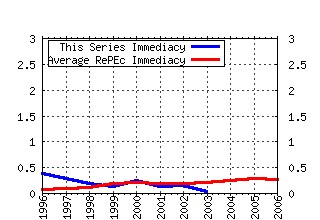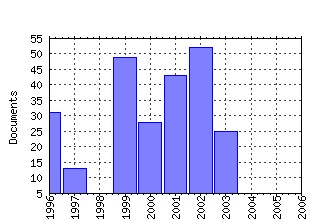
|
|
||||||||||||||||||||||||||||||||||||||||||||||||||||||||||||||||||||||||||||||||||||||||||||||||||||||||||||||||||||||||||||||||||||||||||||||||
Erasmus University Rotterdam, Econometric Institute / Econometric Institute Report Raw citation data, Impact Factor, Immediacy Index, Published documents, Citations received, , Most cited papers , Recent citations and documents published in this series in EconPapers.
Most cited documents in this series: (1) RePEc:dgr:eureir:2000204 A nonlinear long memory model for US unemployment (2000). (2) RePEc:dgr:eureir:2002272 Reverse logistics (2002). (3) RePEc:dgr:eureir:1998145 Does the absence of cointegration explain the typical findings in long horizon regressions? (1998). (4) RePEc:dgr:eureir:2000200 Smooth transition autoregressive models - A survey of recent developments (2000). (5) RePEc:dgr:eureir:2003323 A generalized dynamic conditional correlation model for many asset returns (2003). (6) RePEc:dgr:eureir:1999163 Testing for integration using evolving trend and seasonal models A Bayesian approach (1999). (7) RePEc:dgr:eureir:1999105 Are Living Standards Converging? (1999). (8) RePEc:dgr:eureir:1997134 Flexible seasonal long memory and economic time series (1995). (9) RePEc:dgr:eureir:2003321 Forecasting industrial production with linear, nonlinear and structural change models (2003). (10) RePEc:dgr:eureir:1999177 Learning, network formation and coordination (1999). (11) RePEc:dgr:eureir:2000201 Daily exchange rate behaviour and hedging of currency risk (2000). (12) RePEc:dgr:eureir:1999171 Inference and forecasting for fractional autoregressive integrated moving average models; with an application to US and UK inflation. (1999). (13) RePEc:dgr:eureir:2002282 Changes in variability of the business cycle in the G7 countries (2002). (14) RePEc:dgr:eureir:199729 An efficient optimal solution method for the joint replenishment problemm (1996). (15) RePEc:dgr:eureir:1999141 On SETAR non-linearity and forecasting (1999). (16) RePEc:dgr:eureir:1999167 Adaptive Polar Sampling with an application to a Bayes measure of Value-at-Risk (1999). (17) RePEc:dgr:eureir:2002261 Inflation rates (2002). (18) RePEc:dgr:eureir:2000196 From boom til bust (2000). (19) RePEc:dgr:eureir:2001251 An empirical comparison of default swap pricing models (2001). (20) RePEc:dgr:eureir:2000187 Optimal portfolio choice under loss aversion (2000). (21) RePEc:dgr:eureir:199728 A review of multi-component maintenance models with economic dependence (1996). (22) RePEc:dgr:eureir:2000185 Seasonal smooth transition autoregression (2000). (23) RePEc:dgr:eureir:2000184 Asymmetric and common absorption of shocks in nonlinear autoregressive models. (2000). (24) RePEc:dgr:eureir:1999101 Unit roots and asymetric adjustment - a reassessment (1999). (25) RePEc:dgr:eureir:1997117 Symmetric primal-dual path following algorithms for semidefinite programming (1995). (26) RePEc:dgr:eureir:199739 Bayesian analysis of ARMA models using noninformative priors (1996). (27) RePEc:dgr:eureir:1999144 How to deal with intercept and trend in practical cointegration analysis? (1999). (28) RePEc:dgr:eureir:2001219 Short-term volatility versus long-term growth (2001). (29) RePEc:dgr:eureir:199718 A general approach for the coordination of maintenance frequencies (1995). (30) RePEc:dgr:eureir:1999175 Networks of collaboration in oligopoly (1999). (31) RePEc:dgr:eureir:2002277 Shunting of passenger train units in a railway station (2002). (32) RePEc:dgr:eureir:2002295 Bayes estimates of Markov trends in possibly cointegrated series (2002). (33) RePEc:dgr:eureir:199726 Duality and Self-Duality for Conic Convex Programming (1996). (34) RePEc:dgr:eureir:2003318 A sequential approach to testing seasonal unit roots in high frequency data (2003). (35) RePEc:dgr:eureir:1998103 A Simple Strategy to Prune Neural Networks with an Application to Economic Time Series (1998). (36) RePEc:dgr:eureir:2002264 How to organise return handling (2002). (37) RePEc:dgr:eureir:2000207 Determining the direct mailing frequency with dynamic stochastic programming (2000). (38) RePEc:dgr:eureir:2001224 Testing for common deterministic trend slopes (2001). (39) RePEc:dgr:eureir:2002271 Joint optimization of customer segmentation and marketing policy to maximize long-term profitability (2002). (40) RePEc:dgr:eureir:2003317 Bayesian model selection for a sharp null and a diffuse alternative with econometric applications (2003). (41) RePEc:dgr:eureir:1999111 Bayes estimates of Markov trends in possibly cointegrated series - an application to US consumption and income (1999). (42) RePEc:dgr:eureir:2003302 Multiple-depot integrated vehicle and crew scheduling (2003). (43) RePEc:dgr:eureir:2001230 Are statistical reporting agencies getting it right? Data rationality and business cycle asymmetry (2001). (44) RePEc:dgr:eureir:199747 Bayesian simultaneous equations analysis using reduced rank structures (1996). (45) RePEc:dgr:eureir:1999155 Outlier detection in the GARCH (1,1) model (1999). (46) RePEc:dgr:eureir:199724 A unified treatment of single component replacement models (1996). (47) RePEc:dgr:eureir:1999170 A multivariate STAR analysis of the relationship between money and output (1999). (48) RePEc:dgr:eureir:2003313 A derivative based estimator for semiparametric index (2003). (49) RePEc:dgr:eureir:199736 Equality restricted random variables: densities and sampling algorithms (1996). (50) RePEc:dgr:eureir:1998 Nonparametric estimation of the spectral measure of an extreme value distribution (1998). Recent citations received in: | 2006 | 2005 | 2004 | 2003 Recent citations received in: 2006 Recent citations received in: 2005 Recent citations received in: 2004 Recent citations received in: 2003 (1) RePEc:dgr:eureri:30001228 Combining Column Generation and Lagrangian Relaxation (2003). Erasmus Research Institute of Management (ERIM), RSM Erasmus University / Research Paper Warning!! This is still an experimental service. The results of this service should be interpreted with care, especially in research assessment exercises. The processing of documents is automatic. There still are errors and omissions in the identification of references. We are working to improve the software to increase the accuracy of the results. Source data used to compute the impact factor of RePEc series. |
||||||||||||||||||||||||||||||||||||||||||||||||||||||||||||||||||||||||||||||||||||||||||||||||||||||||||||||||||||||||||||||||||||||||||||||||




